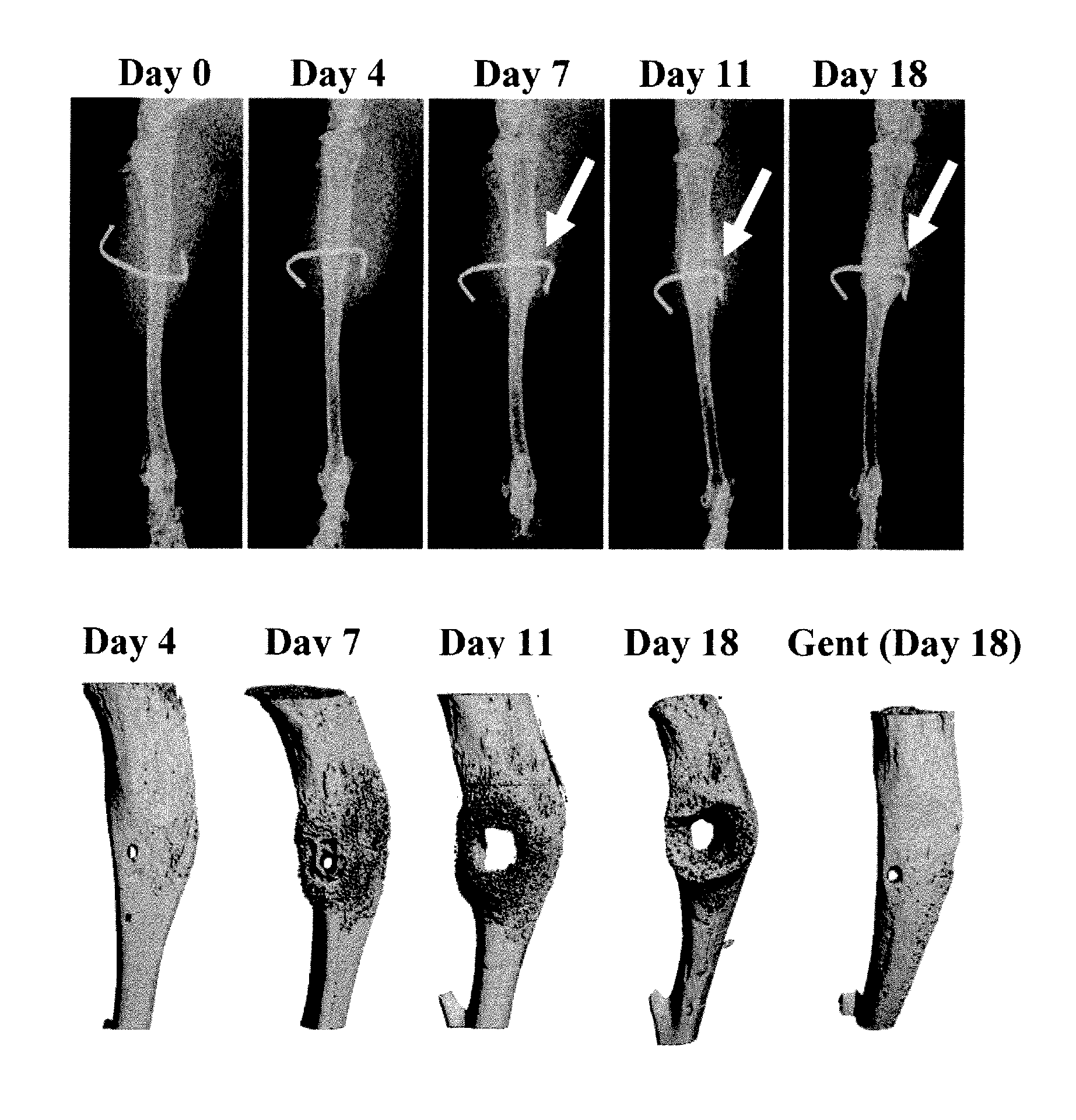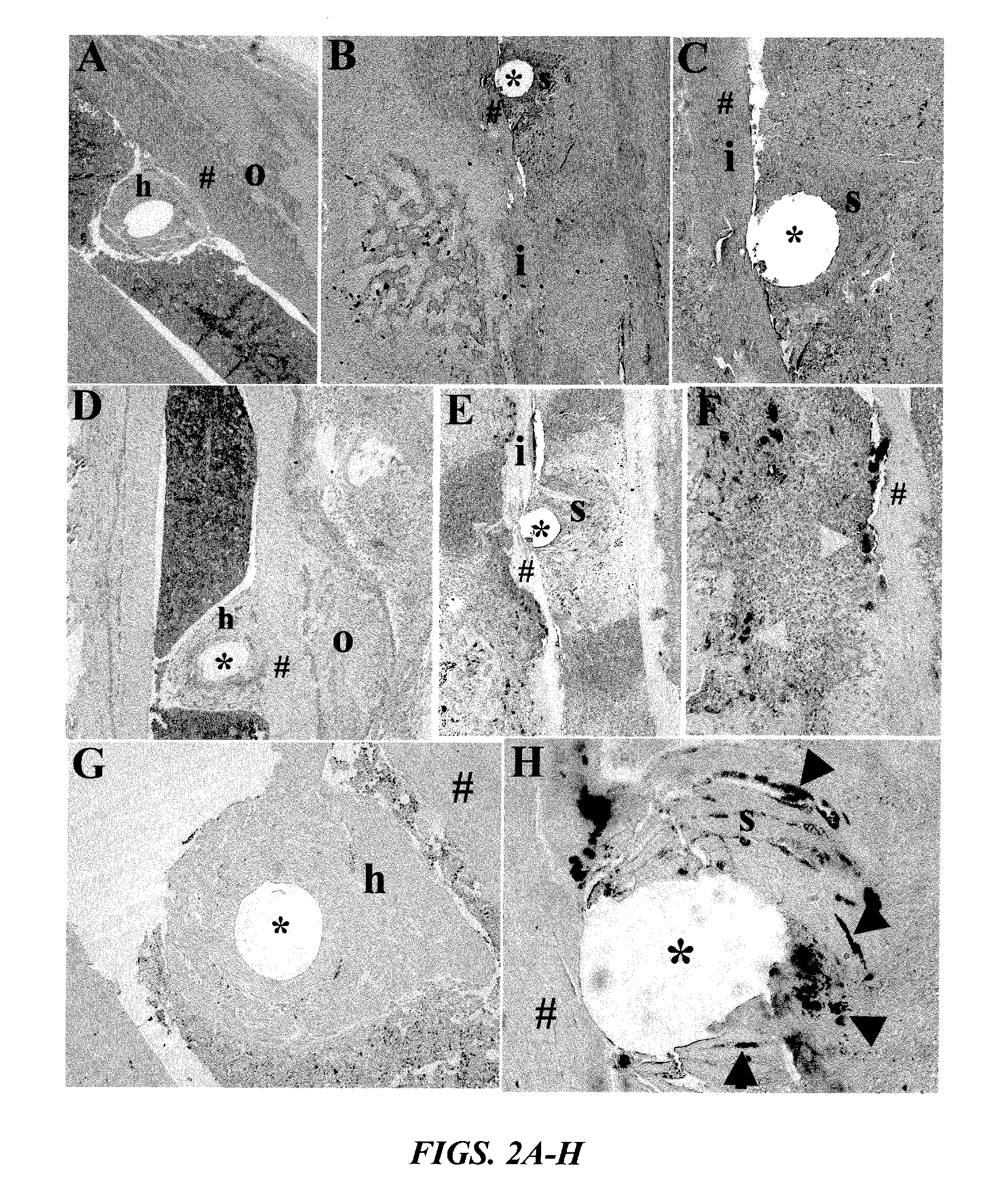Anti-glucosaminidase passive immunization for staphylococcus aureus infections
a technology of staphylococcus aureus and glucosaminidase, which is applied in the field of passive immunization against staphylococcus aureus infection, can solve the problems of infection rate, osteomyelitis (om) remains a serious problem, amputation or death, etc., and achieves reduced gmd activity, increased light scattering, and high affinity interaction
- Summary
- Abstract
- Description
- Claims
- Application Information
AI Technical Summary
Benefits of technology
Problems solved by technology
Method used
Image
Examples
example 1
A Murine Transtibial Model of Implant-Associated Osteomyelitis
[0126]Orthopedic implant-associated OM occurs for both intramedullary devices (i.e. joint prostheses) and transcortical implants (i.e. external fixation devices, FIG. 1A). Although the infection rate of fixation devices is 2.5 times greater, and has an incidence of over 8-times that of total joint prostheses, it is not considered to be as serious because the revision surgery is much simpler (Darouiche, “Treatment of Infections Associated With Surgical Implants,”N. Engl. J. Med. 350(14):1422-9 (2004), which is hereby incorporated by reference in its entirety). While most cases involving an infected transcortical implant can be resolved in a single surgery to relocate the pin and treating the abscess independently, the majority of infected prostheses must undergo two revision surgeries (Darouiche, “Treatment of Infections Associated With Surgical Implants,”N. Engl. J. Med. 350(14):1422-9 (2004), which is hereby incorporated...
example 2
Real Time PCR Quantitation of Osteomyelitis
[0129]There are no known methods to quantify OM. Since it is impossible to effectively extract live bacteria from infected bone to determine bacterial load by classical colony forming units (CFU), a real time PCR method was developed to quantify the number of recoverable nuc genes in DNA samples, as is done to test for contamination in cheese (Hein et al., “Comparison of Different Approaches to Quantify Staphylococcus aureus Cells by Real-Time Quantitative PCR and Application of This Technique for Examination of Cheese,”Appl. Environ. Microbiol. 67(7):3122-6 (2001), which is hereby incorporated by reference in its entirety) and blood (Palomares et al., “Rapid Detection and Identification of Staphylococcus aureus From Blood Culture Specimens Using Real-Time Fluorescence PCR,”Diagn. Microbiol. Infect. Dis. 45(3):183-9 (2003), which is hereby incorporated by reference in its entirety), as a surrogate outcome measure of bacterial load.
[0130]RTQ...
example 3
Kinetics of Infection and Humoral Immunity During the Establishment of Osteomyelitis
[0132]To quantify microbial pathogenesis and host immunity during the establishment of osteomyelitis, a time course study was performed in which mice were given an infected transcortical pin implant in their tibia, and the bacterial load and the host humoral response was determined over time by nuc / β-actin RTQ-PCR and western blot, respectively (FIGS. 3A-C). The results indicate a clear inverse correlation between infection and humoral immunity. Consistent with classical microbial pathogenesis and acquired immunity to extracellular bacteria, these results indicate that the bacteria immediately establish themselves and enter an exponential growth phase, which is extinguished by a neutralizing humoral response after 11 days. Based on the coincidence of the peak bacterial load with the genesis of high affinity IgG antibodies against specific bacterial proteins, it is evident that these “immuno-dominant”...
PUM
| Property | Measurement | Unit |
|---|---|---|
| Fraction | aaaaa | aaaaa |
| Time | aaaaa | aaaaa |
| Composition | aaaaa | aaaaa |
Abstract
Description
Claims
Application Information
 Login to View More
Login to View More - R&D
- Intellectual Property
- Life Sciences
- Materials
- Tech Scout
- Unparalleled Data Quality
- Higher Quality Content
- 60% Fewer Hallucinations
Browse by: Latest US Patents, China's latest patents, Technical Efficacy Thesaurus, Application Domain, Technology Topic, Popular Technical Reports.
© 2025 PatSnap. All rights reserved.Legal|Privacy policy|Modern Slavery Act Transparency Statement|Sitemap|About US| Contact US: help@patsnap.com



